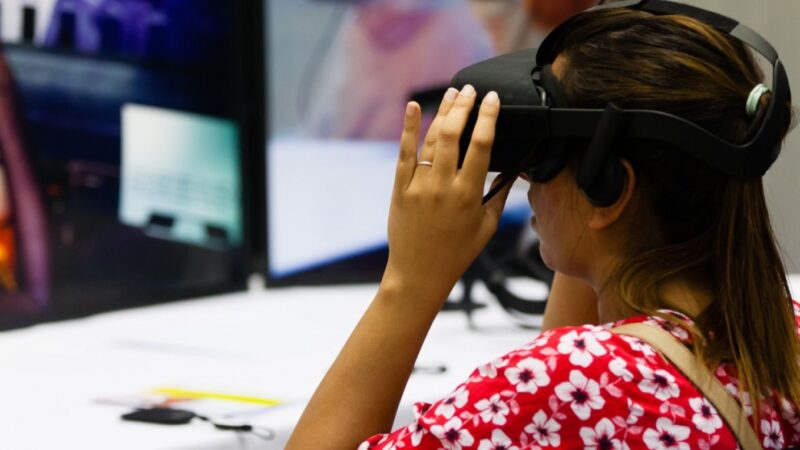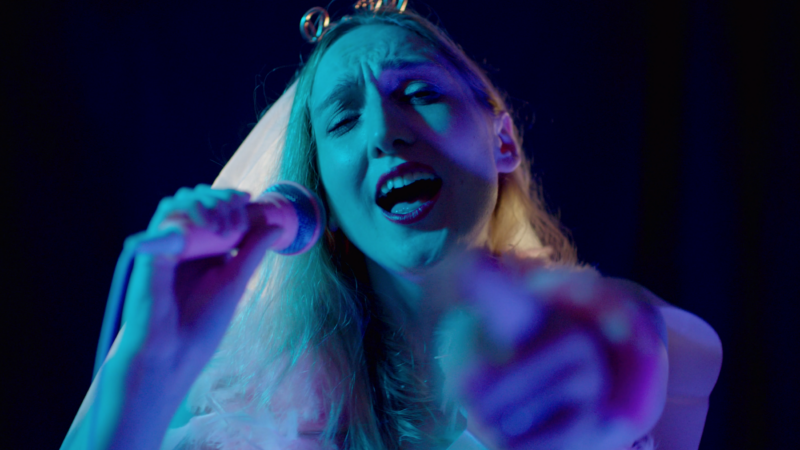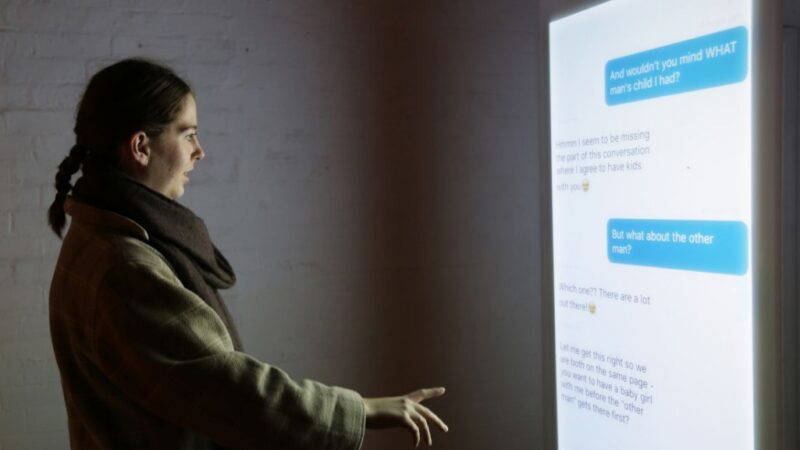Playcraft Live was the first ever live play performed simultaneously on stage and in the computer game Minecraft, both for a live audience and an online audience. Minecraft is a world-building game made up of highly-stylised, pixellated blocky landscapes and figures. Playcraft Live married this world with the living, breathing, unpredictable world of theatre, live-streaming the performance and cutting it together with the scenes in Minecraft. The broadcast is available on YouTube.
“I came up with this really terrible metaphor,” laughs Kieran Griffiths, Artistic Director of Derry Playhouse: “It’s like a dance. You have the old lady of theatre and a contemporary, digital beat-boxer, and they are trying to tango together. And in the middle you have the thorny rose, and that thorny rose is the technology.”
Actually, he continues, although the project brought together a wealth of talent and expertise, it required relatively little in terms of technology. Tony Guillan, Producer, agrees: “The technology to deliver a project like this is actually very simple. The live stream we did was professional and high-end technology, but the tech to deliver the basic concept exists in everybody’s laptops. If you’re a 12-year-old and you want to do a five-minute play in Minecraft, you probably have all the technology you need, and know how to use it.”
The Space commissioned Playcraft Live as the team could see the learning in terms of narrative development and cross-platform production, but also for the potential reach amongst new audiences; Minecraft has 55m monthly players, with many of those in the 8-15 age bracket, which was a group that The Playhouse was keen to engage with.
Moving with the times
Technology has become such a big part of our lives, something that Griffiths has been thinking a lot about: “People should advertise on the pavements because everyone’s looking down, staring at their phones. It’s this idea of what is reality, and what is theatre. From before the beginning of this project, I was interested in virtual identity vs real identity, and the bigger questions that come from having a virtual identity and the courage that comes from hiding behind a keyboard.”
These questions of how the real world and the virtual world interact proved to be a fruitful starting point for this project. Alex Scarrow, author of the TimeRiders series for young adults, was commissioned to write a new play that existed within the pre-established world he had created in the novels.
“When it came to choosing an author to commission, there was a lot of thought put into it,” explains Guillan. “Minecraft is very playful, youthful, sometimes quite silly in terms of its tone, but at the same time, it had to be a real play and a serious piece of theatre. It was aimed at young people, but still needed to explore theatrical form and emotions and ideas and relationships.”
From sceptic to convert
Scarrow was initially unsure about the project: “I was really sceptical! I’d played Minecraft when my son was young enough to enjoy it, and I thought it was a bit of fun. But it’s very primitive – everything is made of little boxes. How can you do a play with just blocks?”
“But I was really interested just how many young boys who don’t read a lot are playing lots of Minecraft, and spending even more time watching videos of other people playing. I thought, this is a really good way to get these boys into the book habit. You generate something for them, you get them involved in a really great story, and then hopefully they continue with the story into books.”
Scarrow’s time-travelling plot leant itself to a mixture of performances live on stage and in Minecraft, with the actors performing onstage some of the time, and then moving into Minecraft. Griffiths says: “When the actors would time-travel, they’d be transferred into the Minecraft world. Their voices were then used for their avatars in Minecraft.”
A new kind of play
The Minecraft aspect of the play was challenging, they all agree. Griffiths says: “You can’t show thought process in Minecraft, because there’s no expression on the faces. So we chose to heighten the delivery of the text. Very quickly, as we worked with the Minecraft production team we saw that dramatic pauses were difficult to achieve. Interrogating that was a lot of fun.”
Scarrow echoes this: “I had to come up with a new type of format for the play, because you not only have stage directions, but also you have virtual directions – what the actors are doing, what the cube avatars are doing. It was a very interesting process. It’s the beginning, potentially, of a new medium.
“With screenplays, you have choices. There are also some subtle things you can do. With Playcraft Live, the action on the stage could get quite emotional but obviously in Minecraft a cube can’t emote. You learn quite quickly to put your explosions in Minecraft and your soul-searching on stage!”
Challenging times
There were many challenges, agrees Guillan: “Bringing a team together who are all very creative and skilled in their own areas, but perhaps had next to no professional experience of each other’s areas was tricky. The Minecraft team know how to play it, how to create projects in it, how the audience use it, how it works online, but they had never produced a play. The Playhouse put on plays all the time, and Kieran is a very good director, but he’s never done anything with Minecraft. Everyone has a different language.”
Scarrow spoke about his cynicism when the project first mooted, but now: “I’ve gone from grumpy skeptic to evangelist! I thought it was a great project, and one I could see doing a world of good, but as a grumpy 52-year-old I wasn’t sure that there could be any meaningful drama occurring in a world made up of blocks. But when we did the first read-through with the cast it started to come alive. Then I saw a couple of days of rehearsals just before the broadcast, and it just worked! They did a clever thing where they can re-skin the cube-people to look like the actors. There was no sense of breaking the fourth wall, because when the characters went into this blocky world they looked like blocks. It all made sense within the piece.”
By March 2018, there had been more than 450k views of the play online through YouTube and Facebook Live, and more than 780k views of content about the production in total. Much of the success in terms of audience engagement came through working with YouTubers who were prominent in Minecraft communities, and particularly those involved with areas such as role play and certain types of building (ItsFunneh, YOGSCAST Martyn, Bigbst4tz), who asked their followers to get involved by creating costumes for the avatars, building sets and commenting on the live stream on the night. This has been transformative for The Space and The Playhouse in understanding the cultural choices of these communities and how to engage with them.
Scarrow is clearly on board for this kind of project, and Griffiths is keen to explore more, too: “There are unlimited possibilities. I’m open to directing Phantom of the Opera in Minecraft! I’m open to directing a play on the refugee crisis in Minecraft. It doesn’t matter what the topic is or how the two worlds marry. I can see now that there’s a way of communicating something wonderful digitally.”
“Having a broadcast camera send a digital signal down the line, and having a Minecraft camera send a signal down the line, and having that mixed and broadcast to the world had never been achieved before, live. I’m not aware of a play that’s never been seen by an audience being broadcast live. Normally, you have previews but this was our first go – our only go! What I learned from it cannot be quantified. We must never place limits or boundaries on what theatre is and can be.”
For more on Playcraft Live read Real and virtual worlds meet in Minecraft play, check out the Playcraft website, or for another Minecraft project supported by The Space view Templecraft to watch the burning of David Best’s monumental ‘Temple’ in Minecraft.
Eleanor Turney is a freelance journalist, editor and arts consultant.
How useful was this resource?




